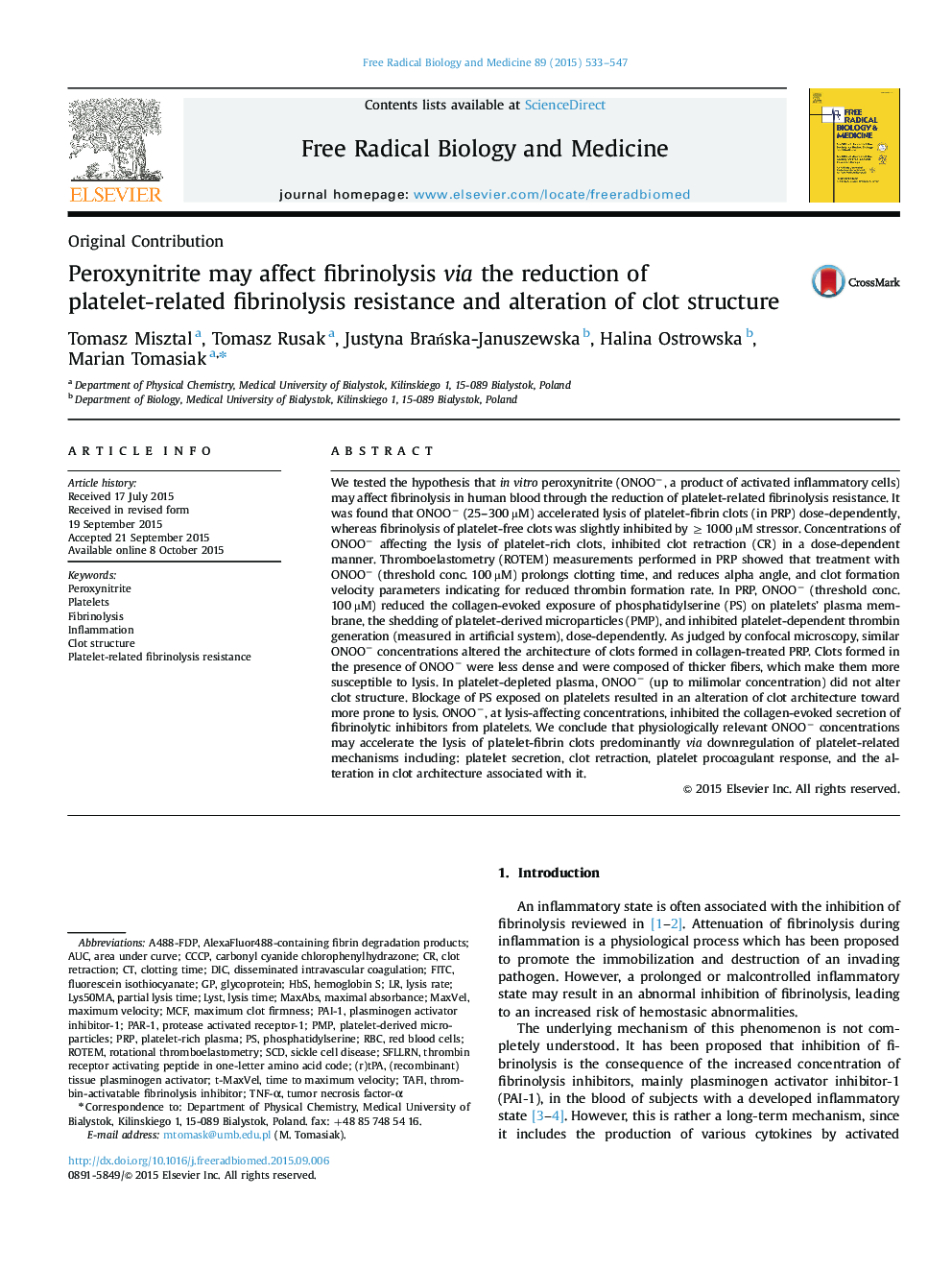| کد مقاله | کد نشریه | سال انتشار | مقاله انگلیسی | نسخه تمام متن |
|---|---|---|---|---|
| 8268645 | 1534954 | 2015 | 15 صفحه PDF | دانلود رایگان |
عنوان انگلیسی مقاله ISI
Peroxynitrite may affect fibrinolysis via the reduction of platelet-related fibrinolysis resistance and alteration of clot structure
ترجمه فارسی عنوان
پروکسینیتریت ممکن است بر اثر فیبرینولیز با کاهش مقاومت فیبریولولیسم پلاکت و تغییر ساختار لخته شود
دانلود مقاله + سفارش ترجمه
دانلود مقاله ISI انگلیسی
رایگان برای ایرانیان
کلمات کلیدی
carbonyl cyanide chlorophenylhydrazonePAI-1CCCPHBSPrPTAFIPAR-1RBCLYSTSCDMCFDICSFLLRNPMPFITCRed blood cells - سلولهای قرمز خونAUC - AUCROTEM - REDinflammation - التهاب( توروم) disseminated intravascular coagulation - انعقاد داخل عضلانی منتشر شده استSickle cell disease - بیماری سلول داسی شکلRotational thromboelastometry - ترومبوالالستومتری چرخشیtumor necrosis factor-α - تومور نکروز عامل αmaximum velocity - حداکثر سرعتMaximum clot firmness - حداکثر سفتی لختهClotting time - زمان لخته شدنClot structure - ساختار لختهTNF-α - فاکتور نکروز توموری آلفاPhosphatidylserine - فسفاتیدیلسرینfluorescein isothiocyanate - فلوئورسین ایسوتیوسیاناتFibrinolysis - فیبرینولیزclot retraction - لخته شدنarea under curve - منطقه تحت منحنیPlasminogen activator inhibitor-1 - مهار کننده فعال کننده پلاسمینوژن-1thrombin-activatable fibrinolysis inhibitor - مهارکننده فیبرینولیز فعال فعال ترومبینHemoglobin S - هموگلوبین SProtease activated receptor-1 - پروتئاز گیرنده فعال 1Peroxynitrite - پروکسی نیتریتplatelet-rich plasma - پلاسمای غنی از پلاکت، PRP، پی آر پیPlatelets - پلاکت هاplatelet-derived microparticles - پلاکت های حاصل از میکروپارسیت هاGlycoprotein - گلیکوپروتئین
موضوعات مرتبط
علوم زیستی و بیوفناوری
بیوشیمی، ژنتیک و زیست شناسی مولکولی
سالمندی
چکیده انگلیسی
We tested the hypothesis that in vitro peroxynitrite (ONOOâ, a product of activated inflammatory cells) may affect fibrinolysis in human blood through the reduction of platelet-related fibrinolysis resistance. It was found that ONOOâ (25-300 µM) accelerated lysis of platelet-fibrin clots (in PRP) dose-dependently, whereas fibrinolysis of platelet-free clots was slightly inhibited by â¥1000 µM stressor. Concentrations of ONOOâ affecting the lysis of platelet-rich clots, inhibited clot retraction (CR) in a dose-dependent manner. Thromboelastometry (ROTEM) measurements performed in PRP showed that treatment with ONOOâ (threshold conc. 100 µM) prolongs clotting time, and reduces alpha angle, and clot formation velocity parameters indicating for reduced thrombin formation rate. In PRP, ONOOâ (threshold conc. 100 µM) reduced the collagen-evoked exposure of phosphatidylserine (PS) on platelets' plasma membrane, the shedding of platelet-derived microparticles (PMP), and inhibited platelet-dependent thrombin generation (measured in artificial system), dose-dependently. As judged by confocal microscopy, similar ONOOâ concentrations altered the architecture of clots formed in collagen-treated PRP. Clots formed in the presence of ONOOâ were less dense and were composed of thicker fibers, which make them more susceptible to lysis. In platelet-depleted plasma, ONOOâ (up to milimolar concentration) did not alter clot structure. Blockage of PS exposed on platelets resulted in an alteration of clot architecture toward more prone to lysis. ONOOâ, at lysis-affecting concentrations, inhibited the collagen-evoked secretion of fibrinolytic inhibitors from platelets. We conclude that physiologically relevant ONOOâ concentrations may accelerate the lysis of platelet-fibrin clots predominantly via downregulation of platelet-related mechanisms including: platelet secretion, clot retraction, platelet procoagulant response, and the alteration in clot architecture associated with it.
ناشر
Database: Elsevier - ScienceDirect (ساینس دایرکت)
Journal: Free Radical Biology and Medicine - Volume 89, December 2015, Pages 533-547
Journal: Free Radical Biology and Medicine - Volume 89, December 2015, Pages 533-547
نویسندگان
Tomasz Misztal, Tomasz Rusak, Justyna BraÅska-Januszewska, Halina Ostrowska, Marian Tomasiak,
